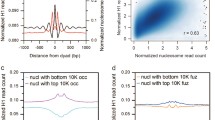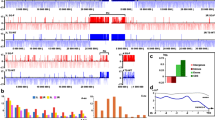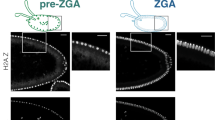Abstract
Eukaryotic genomes are organized in large chromatin domains that maintain proper gene activity in the cell. These domains may be permissive or repressive to the transcription of underlying genes. Based on its protein makeup, chromatin in Drosophila cell culture has been recently categorized into five color-coded states. Suppressor of Under-Replication (SUUR) protein was found to be the major component present in all three repressive chromatin states named BLACK, BLUE, and GREEN and to be depleted from the active YELLOW and RED chromatin types. Here, we addressed the question of developmental dynamics of SUUR binding as a marker of repressed chromatin types. We established genomewide SUUR binding profiles in larval salivary gland, brain, and embryos using DNA adenine methyltransferase identification (DamID) technique, performed their pairwise comparisons and comparisons with the published data from Drosophila Kc cells. SUUR binding pattern was found to vary between the samples. Increase in SUUR binding predominantly correlated with local gene repression suggesting heterochromatin formation. Reduction in SUUR binding often coincided with activation of tissue-specific genes probably reflecting the transition to permissive chromatin state and increase in accessibility to specific transcription factors. SUUR binding plasticity accompanied by the regulation of the underlying genes was mainly observed in BLACK, BLUE, and RED chromatin types. Our results provide novel insight into the developmental dynamics of repressive chromatin and reveal a link to the chromatin-guided regulation of gene expression.





Similar content being viewed by others
References
Bell O, Schwaiger M, Oakeley EJ, Lienert F, Beisel C, Stadler MB, Schubeler D (2010) Accessibility of the Drosophila genome discriminates PcG repression, H4K16 acetylation and replication timing. Nat Struct Mol Biol 17(7):894–900. doi:10.1038/nsmb.1825
Belyaeva ES, Zhimulev IF, Volkova EI, Alekseyenko AA, Moshkin YM, Koryakov DE (1998) Su(UR)ES: a gene suppressing DNA underreplication in intercalary and pericentric heterochromatin of Drosophila melanogaster polytene chromosomes. Proc Natl Acad Sci U S A 95(13):7532–7537
Belyaeva ES, Boldyreva LV, Volkova EI, Nanayev RA, Alekseyenko AA, Zhimulev IF (2003) Effect of the suppressor of underreplication (SuUR) gene on position-effect variegation silencing in Drosophila melanogaster. Genetics 165(3):1209–1220
Belyakin SN, Christophides GK, Alekseyenko AA, Kriventseva EV, Belyaeva ES, Nanayev RA, Makunin IV, Kafatos FC, Zhimulev IF (2005) Genomic analysis of Drosophila chromosome underreplication reveals a link between replication control and transcriptional territories. Proc Natl Acad Sci U S A 102(23):8269–8274
Belyakin SN, Babenko VN, Maksimov DA, Shloma VV, Kvon EZ, Belyaeva ES, Zhimulev IF (2010) Gene density profile reveals the marking of late replicated domains in the Drosophila melanogaster genome. Chromosoma 119(6):589–600. doi:10.1007/s00412-010-0280-y
Bischof J, Maeda RK, Hediger M, Karch F, Basler K (2007) An optimized transgenesis system for Drosophila using germ-line-specific phiC31 integrases. Proc Natl Acad Sci U S A 104(9):3312–3317
Bolstad BM, Irizarry RA, Astrand M, Speed TP (2003) A comparison of normalization methods for high density oligonucleotide array data based on variance and bias. Bioinformatics 19(2):185–193
Brand AH, Perrimon N (1993) Targeted gene expression as a means of altering cell fates and generating dominant phenotypes. Development 118(2):401–415
Chintapalli VR, Wang J, Dow JA (2007) Using FlyAtlas to identify better Drosophila melanogaster models of human disease. Nat Genet 39(6):715–720
da Huang W, Sherman BT, Lempicki RA (2009) Systematic and integrative analysis of large gene lists using DAVID bioinformatics resources. Nat Protoc 4(1):44–57
de Wit E, Greil F, van Steensel B (2005) Genome-wide HP1 binding in Drosophila: developmental plasticity and genomic targeting signals. Genome Res 15(9):1265–1273
Demakova OV, Pokholkova GV, Kolesnikova TD, Demakov SA, Andreyeva EN, Belyaeva ES, Zhimulev IF (2007) The SU(VAR)3-9/HP1 complex differentially regulates the compaction state and degree of underreplication of X chromosome pericentric heterochromatin in Drosophila melanogaster. Genetics 175(2):609–620. doi:10.1534/genetics.106.062133
Ebert A, Lein S, Schotta G, Reuter G (2006) Histone modification and the control of heterochromatic gene silencing in Drosophila. Chromosom Res 14(4):377–392
Eisen MB, Spellman PT, Brown PO, Botstein D (1998) Cluster analysis and display of genome-wide expression patterns. Proc Natl Acad Sci U S A 95(25):14863–14868
Elgin SC (1996) Heterochromatin and gene regulation in Drosophila. Curr Opin Genet Dev 6(2):193–202
Ernst J, Kellis M (2010) Discovery and characterization of chromatin states for systematic annotation of the human genome. Nat Biotechnol 28(8):817–825
Filion GJ, van Bemmel JG, Braunschweig U, Talhout W, Kind J, Ward LD, Brugman W, de Castro IJ, Kerkhoven RM, Bussemaker HJ, van Steensel B (2010) Systematic protein location mapping reveals five principal chromatin types in Drosophila cells. Cell 143(2):212–224
Graveley BR, Brooks AN, Carlson JW, Duff MO, Landolin JM, Yang L, Artieri CG, van Baren MJ, Boley N, Booth BW, Brown JB, Cherbas L, Davis CA, Dobin A, Li R, Lin W, Malone JH, Mattiuzzo NR, Miller D, Sturgill D, Tuch BB, Zaleski C, Zhang D, Blanchette M, Dudoit S, Eads B, Green RE, Hammonds A, Jiang L, Kapranov P, Langton L, Perrimon N, Sandler JE, Wan KH, Willingham A, Zhang Y, Zou Y, Andrews J, Bickel PJ, Brenner SE, Brent MR, Cherbas P, Gingeras TR, Hoskins RA, Kaufman TC, Oliver B, Celniker SE (2011) The developmental transcriptome of Drosophila melanogaster. Nature 471(7339):473–479
Greil F, Moorman C, van Steensel B (2006) DamID: mapping of in vivo protein–genome interactions using tethered DNA adenine methyltransferase. Methods Enzymol 410:342–359
Hiratani I, Takebayashi S, Lu J, Gilbert DM (2009) Replication timing and transcriptional control: beyond cause and effect—part II. Curr Opin Genet Dev 19(2):142–149
Kharchenko PV, Alekseyenko AA, Schwartz YB, Minoda A, Riddle NC, Ernst J, Sabo PJ, Larschan E, Gorchakov AA, Gu T, Linder-Basso D, Plachetka A, Shanower G, Tolstorukov MY, Luquette LJ, Xi R, Jung YL, Park RW, Bishop EP, Canfield TK, Sandstrom R, Thurman RE, MacAlpine DM, Stamatoyannopoulos JA, Kellis M, Elgin SC, Kuroda MI, Pirrotta V, Karpen GH, Park PJ (2011) Comprehensive analysis of the chromatin landscape in Drosophila melanogaster. Nature 471(7339):480–485
Kolesnikova TD, Andreeva EN, Pindiurin AV, Anan'ko NG, Beliakin SN, Shloma VV, Iurlova AA, Makunin IV, Pokholkova GV, Volkova EI, Zarutskaia EA, Kokoza EB, Seneshin VF, Beliaeva ES, Zhimulev IF (2006) Contribution of the SuUR gene to the organization of epigenetically repressed regions of Drosophila melanogaster chromosomes. Genetika 42(8):1013–1028
Kolesnikova TD, Posukh OV, Andreyeva EN, Bebyakina DS, Ivankin AV, Zhimulev IF (2013) Drosophila SUUR protein associates with PCNA and binds chromatin in a cell cycle-dependent manner. Chromosoma 122(1–2):55–66. doi:10.1007/s00412-012-0390-9
Koryakov DE, Walther M, Ebert A, Lein S, Zhimulev IF, Reuter G (2011) The SUUR protein is involved in binding of SU(VAR)3-9 and methylation of H3K9 and H3K27 in chromosomes of Drosophila melanogaster. Chromosom Res 19(2):235–249. doi:10.1007/s10577-011-9193-8
Kwong C, Adryan B, Bell I, Meadows L, Russell S, Manak JR, White R (2008) Stability and dynamics of polycomb target sites in Drosophila development. PLoS Genet 4(9):e1000178. doi:10.1371/journal.pgen.1000178
Luo SD, Shi GW, Baker BS (2011) Direct targets of the D. melanogaster DSXF protein and the evolution of sexual development. Development 138(13):2761–2771
Makunin IV, Volkova EI, Belyaeva ES, Nabirochkina EN, Pirrotta V, Zhimulev IF (2002) The Drosophila suppressor of underreplication protein binds to late-replicating regions of polytene chromosomes. Genetics 160(3):1023–1034
Markstein M, Pitsouli C, Villalta C, Celniker SE, Perrimon N (2008) Exploiting position effects and the gypsy retrovirus insulator to engineer precisely expressed transgenes. Nat Genet 40(4):476–483. doi:10.1038/ng.101
Nordman J, Li S, Eng T, Macalpine D, Orr-Weaver TL (2011) Developmental control of the DNA replication and transcription programs. Genome Res 21(2):175–181. doi:10.1101/gr.114611.110
Pindyurin AV, Moorman C, de Wit E, Belyakin SN, Belyaeva ES, Christophides GK, Kafatos FC, van Steensel B, Zhimulev IF (2007) SUUR joins separate subsets of PcG, HP1 and B-type lamin targets in Drosophila. J Cell Sci 120(Pt 14):2344–2351
Pindyurin AV, Boldyreva LV, Shloma VV, Kolesnikova TD, Pokholkova GV, Andreyeva EN, Kozhevnikova EN, Ivanoschuk IG, Zarutskaya EA, Demakov SA, Gorchakov AA, Belyaeva ES, Zhimulev IF (2008) Interaction between the Drosophila heterochromatin proteins SUUR and HP1. J Cell Sci 121(Pt 10):1693–1703. doi:10.1242/jcs.018655
Reuter G, Spierer P (1992) Position effect variegation and chromatin proteins. Bioessays 14(9):605–612. doi:10.1002/bies.950140907
Riddle NC, Minoda A, Kharchenko PV, Alekseyenko AA, Schwartz YB, Tolstorukov MY, Gorchakov AA, Jaffe JD, Kennedy C, Linder-Basso D, Peach SE, Shanower G, Zheng H, Kuroda MI, Pirrotta V, Park PJ, Elgin SC, Karpen GH (2011) Plasticity in patterns of histone modifications and chromosomal proteins in Drosophila heterochromatin. Genome Res 21(2):147–163. doi:10.1101/gr.110098.110
Roudier F, Ahmed I, Berard C, Sarazin A, Mary-Huard T, Cortijo S, Bouyer D, Caillieux E, Duvernois-Berthet E, Al-Shikhley L, Giraut L, Despres B, Drevensek S, Barneche F, Derozier S, Brunaud V, Aubourg S, Schnittger A, Bowler C, Martin-Magniette ML, Robin S, Caboche M, Colot V (2011) Integrative epigenomic mapping defines four main chromatin states in Arabidopsis. Embo J 30(10):1928–1938
Schotta G, Ebert A, Dorn R, Reuter G (2003) Position-effect variegation and the genetic dissection of chromatin regulation in Drosophila. Semin Cell Dev Biol 14(1):67–75
Schubeler D, Groudine M, Bender MA (2001) The murine beta-globin locus control region regulates the rate of transcription but not the hyperacetylation of histones at the active genes. Proc Natl Acad Sci U S A 98(20):11432–11437
Schwartz YB, Pirrotta V (2007) Polycomb silencing mechanisms and the management of genomic programmes. Nat Rev Genet 8(1):9–22. doi:10.1038/nrg1981
Sher N, Bell GW, Li S, Nordman J, Eng T, Eaton ML, Macalpine DM, Orr-Weaver TL (2012) Developmental control of gene copy number by repression of replication initiation and fork progression. Genome Res 22(1):64–75. doi:10.1101/gr.126003.111
Siegal ML, Hartl DL (2000) Application of Cre/loxP in Drosophila. Site-specific recombination and transgene coplacement. Methods Mol Biol 136:487–495. doi:10.1385/1-59259-065-9:487
Struhl G, Basler K (1993) Organizing activity of wingless protein in Drosophila. Cell 72(4):527–540
Thomas S, Li XY, Sabo PJ, Sandstrom R, Thurman RE, Canfield TK, Giste E, Fisher W, Hammonds A, Celniker SE, Biggin MD, Stamatoyannopoulos JA (2011) Dynamic reprogramming of chromatin accessibility during Drosophila embryo development. Genome Biol 12(5):R43
van Steensel B, Henikoff S (2000) Identification of in vivo DNA targets of chromatin proteins using tethered dam methyltransferase. Nat Biotechnol 18(4):424–428
Wallrath LL (1998) Unfolding the mysteries of heterochromatin. Curr Opin Genet Dev 8(2):147–153
Yang IV, Chen E, Hasseman JP, Liang W, Frank BC, Wang S, Sharov V, Saeed AI, White J, Li J, Lee NH, Yeatman TJ, Quackenbush J (2002) Within the fold: assessing differential expression measures and reproducibility in microarray assays. Genome Biol 3(11):research0062
Zhimulev IF, Belyaeva ES, Makunin IV, Pirrotta V, Volkova EI, Alekseyenko AA, Andreyeva EN, Makarevich GF, Boldyreva LV, Nanayev RA, Demakova OV (2003) Influence of the SuUR gene on intercalary heterochromatin in Drosophila melanogaster polytene chromosomes. Chromosoma 111(6):377–398
Acknowledgments
We thank Dr. Tim Westwood and Canadian Drosophila Microarray Center who performed microarray hybridizations and Dr. Bas van Steensel for Dam-containing vectors. The datasets for this paper have been deposited at NCBI under the reference series GSE33873. The work was supported by the Russian Foundation for Basic Research grants 12-04-00160, 12-04-33080, and 12-01-31128 and by the Program of Presidium of the Russian Academy of Sciences “Molecular and Cellular Biology” (grant no. 6.3).
Author information
Authors and Affiliations
Corresponding author
Electronic supplementary material
Below is the link to the electronic supplementary material.
Supplementary Figure 1
hsp70 promoter from pUAST vector ensures a very low level of Dam-Myc expression. Western blot detection of Dam-Myc protein with the anti-Myc-tag antibodies in salivary glands of y,w strain (negative control, first lane), hsp70 > Dam-Myc strain (second lane) and in hsp70 > Dam-Myc strain induced with salivary gland-specific AB1 Gal4 driver (positive control, third lane). anti-Tubuline antibodies were used as a load control. Asterisk shows a non-specific band appearing due to over-exposure of the membrane. (JPEG 69 kb)
Supplementary Figure 2
Effect of data normalization. A – distribution of the raw DamID data in the four samples. B – the same after the normalization step. Scale – Log2(Dam-Myc-SUUR/Dam-Myc). C – K-means clustering of the normalized data in the four samples reveals a substantial variation of SUUR binding in different cell types. (JPEG 750 kb)
Supplementary Figure 3
Examples of SUUR profile variability in different biological samples. The colors and legends are the same as on the Fig. 1. (JPEG 496 kb)
Supplementary Figure 4
Correlation of SUUR binding dynamics and gene activity in six pairs of samples. The legend is the same as in Fig. 3c. (JPEG 581 kb)
Supplementary Figure 5
Variability of SUUR binding near the borders and towards the centers of domains in different chromatin types. Portions of differentially bound genes in 1 kb bins starting from the borders of the domains of different types are presented. No differences from the distributions presented in the Fig. 5a were found indicating that observed variation of SUUR binding is not a bias stemming from the domain borders. (JPEG 457 kb)
Supplementary Figure 6
A test study of H3K36me3 variability between Kc cells and 0-12h embryos. A – distribution of H3K36me3 histone mark across five chromatin types. B – variability of H3K36me3 levels in five chromatin types assessed with the same analytic tools as for SUUR. GREEN chromatin tends to loose H3K36me3 in embryos while BLUE chromatin accumulates H3K36me3. Other chromatin types do not follow this pattern. This picture is strikingly different from the observed variability of SUUR (Fig. 5a). (JPEG 227 kb)
Supplementary Table 1
(XLS 2334 kb)
Supplementary Table 2
(XLS 34 kb)
Supplementary Table 3
(XLS 42 kb)
Supplementary Table 4
(XLS 149 kb)
Supplementary Table 5
(XLS 117 kb)
Rights and permissions
About this article
Cite this article
Maksimov, D.A., Koryakov, D.E. & Belyakin, S.N. Developmental variation of the SUUR protein binding correlates with gene regulation and specific chromatin types in D. melanogaster . Chromosoma 123, 253–264 (2014). https://doi.org/10.1007/s00412-013-0445-6
Received:
Revised:
Accepted:
Published:
Issue Date:
DOI: https://doi.org/10.1007/s00412-013-0445-6




